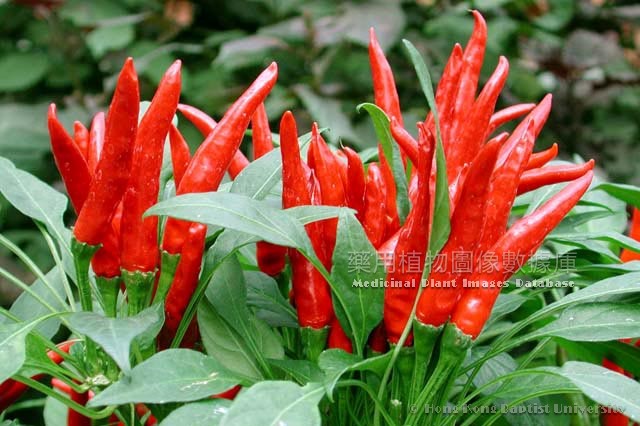|
|
|
Capsicum annuum L.

|
English Name |
Long Pepper, |
|
Latin name |
Capsicum annuum L. |
|
Family & Genus |
Solanaceae, Capsicum |
|
Description |
Annual or rooted perennial herbs, 40-80cm tall. Simple leaves alternate, nodes at the top of branches not extended, binate or clustered; blades oblong-oval, oval or oval-lanceolate, 4-13cm long, 1.5-4cm wide, entire, apex acute, base gradually narrow. Flowers solitary, drooping; calyx cup-shaped, not prominent 5 teeth; corolla white, lobes oval; stamens 5; pistil 1, ovary superior, 2 chambers, a few with 3 chambers, style linear. Berries long finger-like, apex acuminate and often curved, green when immature, red, orange or purple after maturation, taste spicy. Seeds numerous, flat-reniform, light yellow. Flowering and fruiting: May to November. |
|
Distribution |
Biological nature: warm, cold and frost vulnerable, avoiding high temperature and solarization, preferring humid but waterlogging-vulnerable, and is fertilizer-tolerant. Cultivated in most parts of China. The medicinal materials are mainly produced in most parts of China. |
|
Part Used |
Medical part: stems, leaves and fruits. Chinese name: Lajiaojing, Lajiaye and Lajiatou. |
|
Harvest & Processing |
Collected green pepper when fruits grow in full size and turn dense, pericarp firm and glossy; collected all mature fruits for dried pepper. Can make into salted chili, clear sauce chili, shrimp sauce chili. Dry pepper can make into dry products. |
|
Chemistry |
Fruits contain various alkaloids, such as capsaicin, dihydrocapsaicin, nordihydrocapsaicin, homocapsaicin and homodihydrocapsaicin, etc. |
|
Pharmacology |
Having effect on digestive system; antibacterial, kill parasites; rubefacient; having effect on circulatory system. |
|
Properties & Actions |
Pungent, hot.Warming inside, dispelling cold; bring down qi and promoting digestion. |
|
Indications & Usage |
Treating gastric cold and qi stagnancy, gastric and abdominal swelling pain, vomiting, dysentery, rheumatalgia, frostbite.Internal: made as pills or powders, 1-3g. External: appropriate amount, decocted for fumigating or triturated for application. |
|
Examples |
1. Treat dysentery and diarrhea: Long pepper 1. Grind into powder and prepare pills, wrap with hot beancurd skin in morning, swallow.
2. Treat malaria: Long pepper seeds, 1 for each year, and 20 at the most, 3 times a day, swallow with boiled water, and take consecutively for 3-5 days.
3. Treat frostbite: strip peels of Long pepper and paste. |
|
Permanent URL:https://sys01.lib.hkbu.edu.hk/cmed/mpid/detail.php?herb_id=D00478 |
|
|
|

